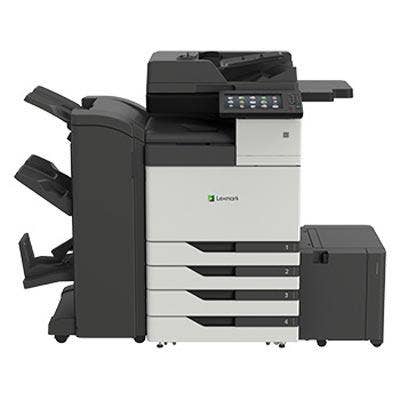Lexmark's North American Channel VP Chavers Looks To New Partners, SMBs To Grow New Cloud Offerings
Driving Partner Sales
As Lexmark embarks on a reinvigorated channel push spearheaded by global channel chief Sammy Kinlaw, Greg Chavers, the company's North American channel chief, is on the front-lines of its renewed effort to increase the number of partners as it rolls out a new line of products and services. While Lexmark is looking for channel growth world-wide, this side of the Atlantic does the "heavy lifting" Chavers said.
"You've got EMEA, you've got some of the other [geographies] abroad, but for the most part we do the heavy lifting, when you think about it as a proportional part of the number and [Kinlaw's] goal and target," he said.
Chavers, who has been with Lexmark since September 1996, was appointed vice president of North American channel sales in 2017. He said the company has tried, every year to "push the envelope."
"That's helped us expand with some of the partners where we already have a pretty good wallet share, but it's also given us an opportunity to go pursue and recruit in some of these white spaces, this long tail that [Kinlaw] is talking about. I don't think you can do one or the other," he said. "I think you're going to have to do both if you want to kick the competition."
Edited excerpts of the conversation follow.

With all the talk about growing the channel for Lexmark, how do you plan to make that happen?
I think we have to do it in a disciplined way. The last thing partners want to hear is that you're adding more partners. That just means more competition for them and more pressure on their margins. We have a pretty good practice and discipline where we look at the different metro areas and we understand what kind of share we have in those areas and how many dealers it can support. If we have dealers that are getting the market share number that we think we should be getting in a particular marketplace, then we're good. We won't add any others there. Then if we have some that aren't performing, we'll terminate them. We'll add someone that's more committed to Lexmark.
We still have a lot of territory out there that's white space for us where we really don't have distribution. In a lot of these areas of white space. It's not in any of the major metro areas of course, but it's in some of these smaller, tier three/tier four-type cities, from a size perspective, looking at some of those and seeing if there's the right partner in those areas that service those areas to try to link up with.

Without an exclusive relationship, how do you differentiate Lexmark from the other brands among your partners?
What we try to be is their growth partner. So we say, "Look, we want you to lead with Lexmark A4 in solutions, but at the end of the day we want to be your main line A4 offering. We know you're leading with Canon or whatever, but on the A4 side we want you to lead with Lexmark." On the traditional side it's the same thing, selling everything that's out there. One of the biggest challenges that you have, you know from a consideration perspective, is just being relevant to some of those partners. It is hard to do, when you have several manufacturers. That's just on the print side. Some of these are marketing PCs and servers and multiple brands across all that kind of stuff. You can get lost in the shuffle if you don't have a legitimate program.

One of the ways Lexmark is hoping to build more mindshare among channel partners is by offering cloud services opportunities with its new line of printers. Tell me a little about that?
It's going to be a great opportunity for us to differentiate ourselves in the marketplace. There's going to be no doubt about it, it's going to appeal to our partners. They're going to be able to harness the power of our managed print service practice -- that we've been great at for quite some time, a leader at especially on the enterprise side -- and be able to really package that, so that we can deliver it to some of their small-to-medium businesses and not burden the dealer and the partner with a big, upfront investment. That's the reason a lot of them don't do managed print services, because it's a lot commitment and investment not only in resources, but in tools.
How unique is this product compared to what your competition offers?
Quite frankly, I don't think anyone is really doing it. I think a lot of people are talking about it, so they've got some concepts out there. I think in practice, no one is really executing on that. Just because it's one of those things the market hasn't adopted yet. So there's going to be some education in the marketplace. Whoever is leading on that path could get a few cuts and bruises as the others try to figure out if there's a legitimate marketplace where individuals want to pay a fee for a printer, and everything is included in that fee … I think it's going to happen sooner rather than later. I just think we have to get our ducks in a row and make sure we've got a practice built with partners. I think the cloud gives us the opportunity to do that.

What have you heard from your partners about the cloud offerings?
We had some feedback in some of these roadshows that we're doing. The feedback has been overwhelmingly positive on that front. I think they see some of the upside. They understand this is going to be a good lever for them going forward. We're going to be able to give them more opportunities to drive managed print services. They've been talking about managed print services for eight or nine years or so, and so it's really been slow to be embraced by the partner community.

Have you heard any critical feedback from partners about expanding with this cloud offering?
Probably 80 percent of the enterprise is engaged in managed print services. When you think about these mid-market-type enterprise accounts, and you keep going down to small-to-medium-type businesses, that's the growth opportunity for managed print services. So the concern is are they going to feel comfortable with their stuff floating in this cloud? For a lot of them, it's going to be an education. Are they going to be comfortable that their information is going to be secure.? We're going to have to do a good job communicating that right. If I was an [SMB], I'd have a little reservation about my information, so we're going to have to do a good job.

What's going to be the key to Lexmark winning market share in the next few years?
This market still, even with [the number of printed] pages declining -- I think the industry said it's around a couple percent over the next several years in this marketplace -- even with that, it's still a $150 billion marketplace. That's huge. And think about it from our perspective, from an A4 [perspective], just in North America, just A4 devices out there, you're probably talking about six-plus million devices just in the last year annually that were sold. To me it's going to [rest] on who is the best at building the right relationships with the partners and trust to where they think that you're really a trusted advisor, and your team members out there are catering to them. I think that's going to be a key piece of it going forward, on the who wins in this marketplace.